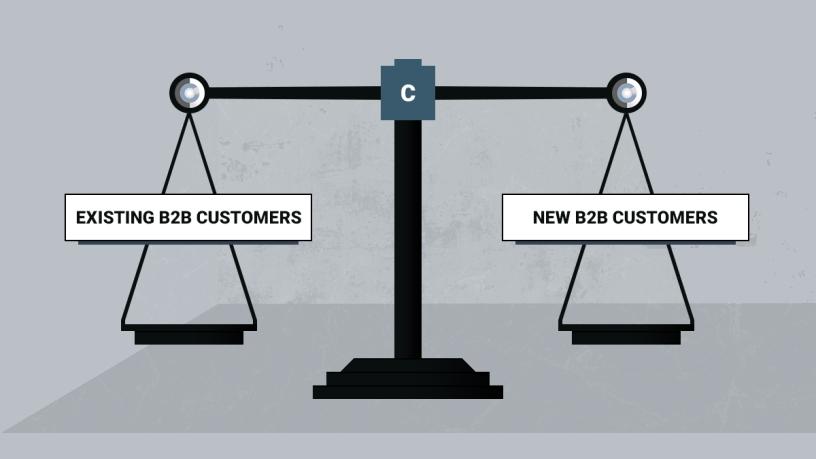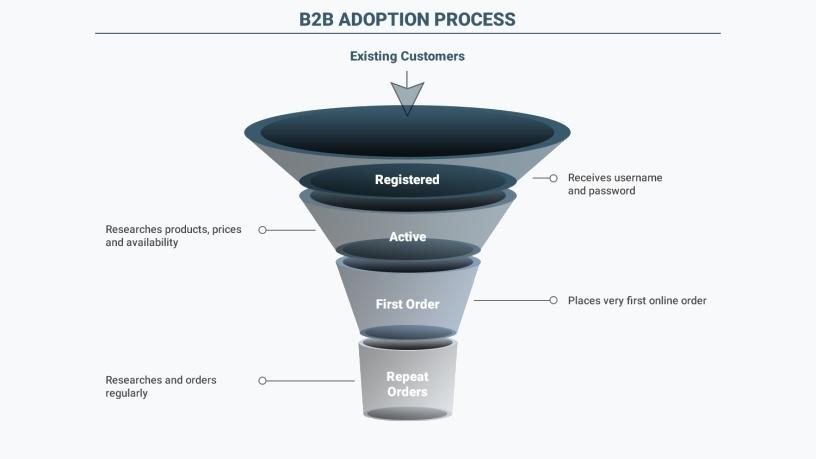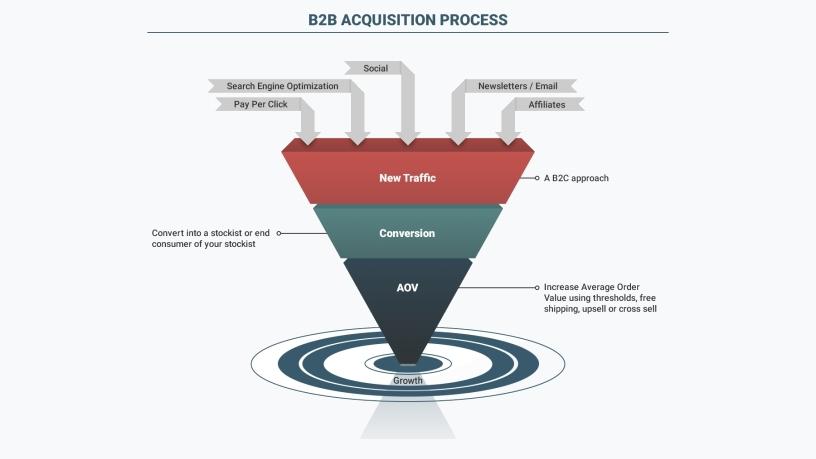
With your e-commerce site ready to launch, you might think the next step for B2B online success is ensuring successful adoption. And you'd be right that it's critical to get your offline customers online as soon as possible.
"Don't stop there, though," says Jannie du Toit, CEO of Comalytics. "Your new B2B e-commerce system is capable of so much more than supporting existing customers. It's also a powerful acquisition tool that can exponentially expand your customer network."
The truth: B2B online success is the result of both adoption and acquisition.
Why adoption is (one) key for B2B online success
B2B e-commerce systems are usually designed around existing customers. Your job then becomes to convince them to use the site, not just once, but regularly.
There are several reasons why getting your customers online is important for B2B success:
* Customers who use multiple channels have a much higher lifetime value.
* Revenue from online customers is much higher as many limitations are removed. They can order anytime they like, without a rep, and easily find products on your site that they didn't know they needed.
* Online is the way of the future and you're putting your business at risk if you don't make the move now.
How does the traditional B2B online adoption approach work?
Your first priority should always be getting your existing customers to start using the new online platform. You and/or your sales reps probably already have a trust relationship with them, making this process that much easier.

Step 1: Registration
Let your customers get their username and password as effortlessly as possible. Their account should be linked in your ERP to their company account, so they can access all their information, like customer-specific products, pricing and discounts. They'll also be able to see their company credit limits, order history and T&Cs, and track their deliveries.
Critical elements:
* Know your customers' needs, preferences and concerns, and make sure your platform can cater for these.
* Create an outstanding customer experience by making the system easy to use and understanding your customers' workflow.
* Make sure your system is flexible enough to adjust to customer-specific processes where it needs to.
* Plan your onboarding process very well. A combination of email marketing and sales rep visits works best. Train your customers step by step to help them adopt the system.
Step 2: Online activity
Getting them to actually use the site for the first time can often be the most challenging step; people don't like change. Support them as much as you can, and show them how easy it is to find out:
* If you have what they want;
* How much it costs; and
* How long it will take to get it.
Critical elements:
* Make sure your online system is completely responsive to all devices.
* Integrate your e-commerce site with your ERP, so the customer's specific data automatically appears when they log in. Very often that's enough to immediately sell them on the system.
Step 3: First online order
This is a crucial step. How well it goes determines whether your customer will ever order online with you again. It should be "the perfect order", so smooth and easy that the customer immediately becomes an online convert. Also, while research shows that most B2B customers these days want to be self-sufficient, they do need support to get there.
Critical elements:
* Ensure your B2B e-commerce site syncs with your other systems immediately (or at least very regularly), so information on the site is always up to date. Purchase orders should also immediately sync with your back-office systems, eliminating admin and speeding up the purchasing cycle.
* Support teams, for example call centre agents and sales reps, should be completely up to speed on the new processes, right from the word go, so they can answer any questions customers may ask.
* Get your sales team on board by involving them early in the design process, and incentivising them for online orders as much as (if not more than) offline ones.
* Incentivise your customers to adopt the system by creating loyalty programmes that really make a difference, for example, volume discounts, promotions or gamification (depending on your customer base).
Step 4: Regular ordering or adoption
If you've got it right, your customers should quickly get to a point where they automatically go online to research and order products.
Critical elements:
* Make sure all your internal logistical processes, like picking and packing, are geared to support online orders as much as offline ones. Every order needs to go smoothly, or customers will simply go back to their previous offline ordering methods or even leave for a competitor.
* It's critical to have a board-level sponsor for your e-commerce development and onboarding programme. You also need a very strong, business-minded project manager to drive the implementation and adoption of the system until you reach your adoption target.
The role of your sales team in e-commerce success
Depending on your company structure, your sales team may be able to ease this transition with some step-by-step, in-person or telephonic training. Be careful not to create a new dependency there though. The aim is to get your customers as self-sufficient as possible, so your sales reps are freed up to truly help customers (and you) grow their businesses.
Acquisition is the second key to B2B online success
Says Du Toit: "Adoption of your B2B e-commerce system is vital for success. To truly boost growth and outstrip your competitors, though, also consider an acquisition approach for your new B2B online system."
The essence of acquisition is getting new visitors to come to your site, then converting them into paying customers. To accomplish this, your products need to be online in an 'open to the public' catalogue. This is important for two reasons:
* B2B buyers are becoming more like B2C customers every day. They use tools like Google and social media to find brands and products that work for them and their customers.
* End-consumers also search online themselves to find stockists of the products they need.
In both cases, if people can't find your products online using search engines, you lose out on their immediate and any future business.
With a public catalogue, your products become searchable. You still get to choose how much information is public; you may decide to keep pricing and inventory information restricted at this point.
How does the B2B online acquisition approach work?
This framework can be used by B2C e-commerce companies, as well as by online manufacturers, wholesalers and distributors. It's based on a simple formula:
Traffic x conversion x average order value (AOV) = revenue

To increase revenue and top-line growth, companies must pull one of three levers in their online business: traffic, conversion or average order value. A fourth possible lever is to grow existing customers' spend or purchase frequency.
For B2B companies to follow an acquisition strategy, they need to put on their B2C marketing hats.
Step 1: Grow new traffic
With a searchable catalogue, your next task is to get your products well placed on search engines and other platforms so people actually come to your site.
Critical elements:
* Attracting new customers requires an integrated marketing approach, including social media campaigns, content marketing and traditional online advertising, as well as SEO. Make sure you promote your products here, not just your brand, as they are what B2B buyers are searching for.
* Help your stockists promote your products in a consistent way by providing them with quality information and marketing materials that help them sell more, benefiting both of you. See our B2B 123 approach to understand this better.
Step 2: Convert new traffic into B2B or end-customers
Once visitors have found what they're looking for on your site, the next step should require minimal effort and clicks from them. That step could be:
1. Becoming a stockist of your products
Make it really simple for them to request a login and become a buyer.
2. Buying from one of your stockists
When you are available to the public online, end-consumers will find your products too. Help them find their most convenient stockist, who will of course be buying from you, increasing both their sales and yours.
Critical elements:
* Keep an eye on your KPIs, especially conversion rates of visitors into (a) new stockists of yours, and (b) new customers of one of your stockists.
* Gather e-mail addresses from your site visitors, whether they are potential stockists or end-consumers, then make use of e-mail marketing to convert them.
* Offer helpful blogs and videos on your open catalogue to attract, engage and convert customers.
Step 3: Increase average order value (AOV)
While increasing AOV is mainly aimed at customers using your full e-commerce site, you may still use certain elements in your open catalogue. Displaying general promotions, discounts or related products, reviews, or cross-sell and up-sell options, encourages conversion and, later, a larger order.
The bottom line....
For true B2B e-commerce success, it's not enough to simply move your existing customers online. While that's important and needs to be done well, your biggest growth will come from using your e-commerce site to acquire new customers, and to help your network of stockists to grow their businesses (so that yours grows too).
Don't rely only on adoption for your B2B online success. It's in acquisition that you will truly surpass your competitors.
Share
